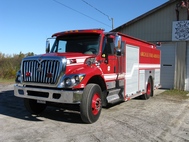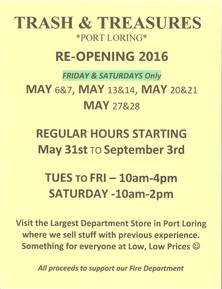Argyle Fire Department
Click Here to view the Fire Services Agreement

The Argyle Fire Department serves the population of Lost Channel, Loring, Port Loring, Arnstein, Golden Valley, and Commanda.
CITY FIRE DEPARTMENTS VS RURAL FIRE DEPARTMENTS
Most city fire departments are comprised of both professional and volunteer firefighters. These firefighters are on rosters so they will have a ladder crew, interior attack team, etc. This means that the Incident Commander knows exactly which personnel will be turning up to assist in the event of a call. Totally volunteer departments such as Argyle are reliant upon only whoever is available at any given time should a call come in. This means that it is not until trucks are rolling that we know how many are responding and who they are. As most firefighters have full time jobs, calls that happen during the day may only have a few responders putting a greater workload on those that do. We appreciate greatly those employers of firefighters that allow their employees to attend serious calls during business hours.
The most important aspect of firefighting that is different to our city counterparts is that of water supply. City departments rely on fire hydrants to obtain water, whereas we operate mostly using the water that we carry on the pumper trucks first, then water we can procure close to the incident. As the tanker trucks arrive, we drop a port a tank, which is a large plastic pool supported on all sides by a fold up steel cradle. We then drop water from the tanker into the port a tank and attach a rigid suction hose back to the pumper which continues to pump water onto the fire. The tanker then drives off, leaving the port a tank in place until another tanker replenishes that supply. The empty tankers then need to be refilled, we use lakes, ponds and streams closest to the scene of the fire. We have portable floating pumps or larger portable pumps to draw water up and into the tanker trucks before they go back to the fire scene and fill the port a tank.
As you can imagine this involves a lot of equipment and a lot of work. It also involves a lot of careful choreographing to ensure that everything runs smoothly. The manpower involved includes crews on scene putting out the fire, crews at the water source ensuring that the tankers are refilled as quickly as possible and tanker drivers. Winter can make things a lot more difficult, we have to drill holes through the ice with an auger and then pump that water up to the tankers which simply due to the temperature can be a much slower procedure and in the event of fire, time is the enemy.
Argyle Fire Department also responds to code 4 medical calls. Some of these calls are in remote areas that an ambulance simply cannot get to. We procured an Argo and trailer a few years ago which is essential in remote rescue situations. The Argo is equipped with a stretcher for patient evacuation and has room enough to transport fire fighting equipment when necessary. We are able to use the Argo in all seasons including for snowmobile and ATV accident rescues as well as forest fire situations.
Argyle Fire Department covers a geographic area that runs approximately from Lost Channel along Hwy 522 east to Hwy. 524, a distance of approximately 80 km. This includes all of the side roads, remote bush locations and all of the islands on all of the numerous lakes in that area.
Argyle Fire Departments responsibilities include structure fires, both exterior attack as well as interior rescue, medical code 4 calls, remote rescue calls for patient stabilization and evacuation, motor vehicle accidents including extrication, forest fire calls, and vehicle fires. This involves a lot of diverse equipment, trucks and vehicles.
Funding for the Argyle Fire Department comes from three sources. The Ontario Fire Marshalls Office provides us with equipment such as bunker gear and some trucks. Financial funding comes from a portion of the LSB community taxes. Last year this was approximately $67.00 per parcel of vacant land or residential property in our area. Trash and Treasures, a voluntary organization also provides upwards of $30,000 per annum for which we are extremely grateful.
In the past year we were able to purchase a new command vehicle to replace the previous 1996 truck. The new truck is a GMC four wheel drive, crew cab with an 8 foot bed. It is equipped with telephone service so that we can call the OPP, MNR and Hydro while on scene. This has been a huge asset to the department and will last for at least another twenty years. This vehicle allows the fastest response to scene, allowing us to quickly size up the situation and make decisions accordingly.
In the past twelve months we have attended three major house fires, two dump fires, a number of hydro pole fires, a car and a trailer fire, numerous code four medical calls, and two forest fires, one of which was on an island. As you can see, more equipment is required in a rural volunteer department compared to a city department. While the calls are less frequent, they are far more diverse in nature.
We hope that you have a better understanding as to how your fire department works.
Argyle Fire Department
CITY FIRE DEPARTMENTS VS RURAL FIRE DEPARTMENTS
Most city fire departments are comprised of both professional and volunteer firefighters. These firefighters are on rosters so they will have a ladder crew, interior attack team, etc. This means that the Incident Commander knows exactly which personnel will be turning up to assist in the event of a call. Totally volunteer departments such as Argyle are reliant upon only whoever is available at any given time should a call come in. This means that it is not until trucks are rolling that we know how many are responding and who they are. As most firefighters have full time jobs, calls that happen during the day may only have a few responders putting a greater workload on those that do. We appreciate greatly those employers of firefighters that allow their employees to attend serious calls during business hours.
The most important aspect of firefighting that is different to our city counterparts is that of water supply. City departments rely on fire hydrants to obtain water, whereas we operate mostly using the water that we carry on the pumper trucks first, then water we can procure close to the incident. As the tanker trucks arrive, we drop a port a tank, which is a large plastic pool supported on all sides by a fold up steel cradle. We then drop water from the tanker into the port a tank and attach a rigid suction hose back to the pumper which continues to pump water onto the fire. The tanker then drives off, leaving the port a tank in place until another tanker replenishes that supply. The empty tankers then need to be refilled, we use lakes, ponds and streams closest to the scene of the fire. We have portable floating pumps or larger portable pumps to draw water up and into the tanker trucks before they go back to the fire scene and fill the port a tank.
As you can imagine this involves a lot of equipment and a lot of work. It also involves a lot of careful choreographing to ensure that everything runs smoothly. The manpower involved includes crews on scene putting out the fire, crews at the water source ensuring that the tankers are refilled as quickly as possible and tanker drivers. Winter can make things a lot more difficult, we have to drill holes through the ice with an auger and then pump that water up to the tankers which simply due to the temperature can be a much slower procedure and in the event of fire, time is the enemy.
Argyle Fire Department also responds to code 4 medical calls. Some of these calls are in remote areas that an ambulance simply cannot get to. We procured an Argo and trailer a few years ago which is essential in remote rescue situations. The Argo is equipped with a stretcher for patient evacuation and has room enough to transport fire fighting equipment when necessary. We are able to use the Argo in all seasons including for snowmobile and ATV accident rescues as well as forest fire situations.
Argyle Fire Department covers a geographic area that runs approximately from Lost Channel along Hwy 522 east to Hwy. 524, a distance of approximately 80 km. This includes all of the side roads, remote bush locations and all of the islands on all of the numerous lakes in that area.
Argyle Fire Departments responsibilities include structure fires, both exterior attack as well as interior rescue, medical code 4 calls, remote rescue calls for patient stabilization and evacuation, motor vehicle accidents including extrication, forest fire calls, and vehicle fires. This involves a lot of diverse equipment, trucks and vehicles.
Funding for the Argyle Fire Department comes from three sources. The Ontario Fire Marshalls Office provides us with equipment such as bunker gear and some trucks. Financial funding comes from a portion of the LSB community taxes. Last year this was approximately $67.00 per parcel of vacant land or residential property in our area. Trash and Treasures, a voluntary organization also provides upwards of $30,000 per annum for which we are extremely grateful.
In the past year we were able to purchase a new command vehicle to replace the previous 1996 truck. The new truck is a GMC four wheel drive, crew cab with an 8 foot bed. It is equipped with telephone service so that we can call the OPP, MNR and Hydro while on scene. This has been a huge asset to the department and will last for at least another twenty years. This vehicle allows the fastest response to scene, allowing us to quickly size up the situation and make decisions accordingly.
In the past twelve months we have attended three major house fires, two dump fires, a number of hydro pole fires, a car and a trailer fire, numerous code four medical calls, and two forest fires, one of which was on an island. As you can see, more equipment is required in a rural volunteer department compared to a city department. While the calls are less frequent, they are far more diverse in nature.
We hope that you have a better understanding as to how your fire department works.
Argyle Fire Department



